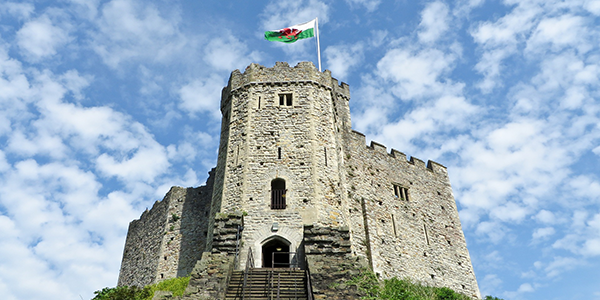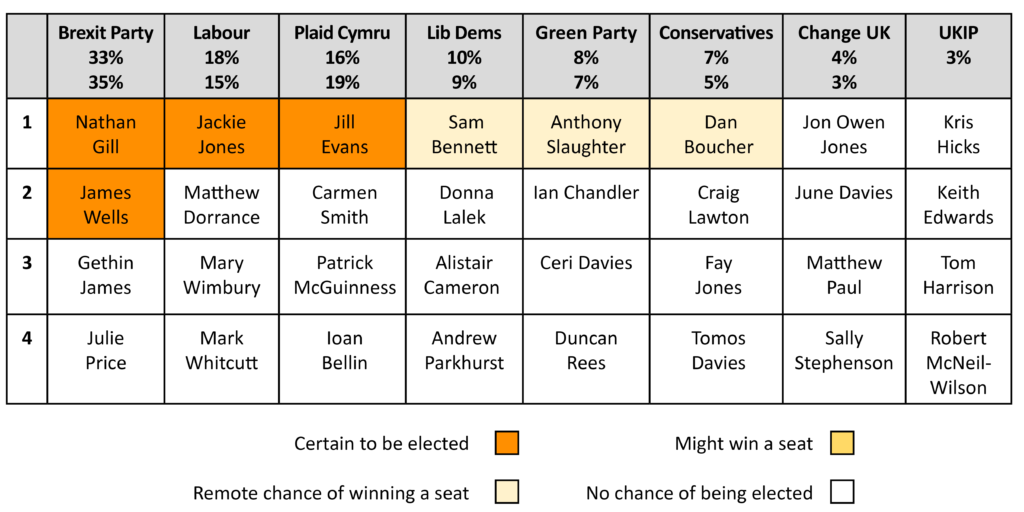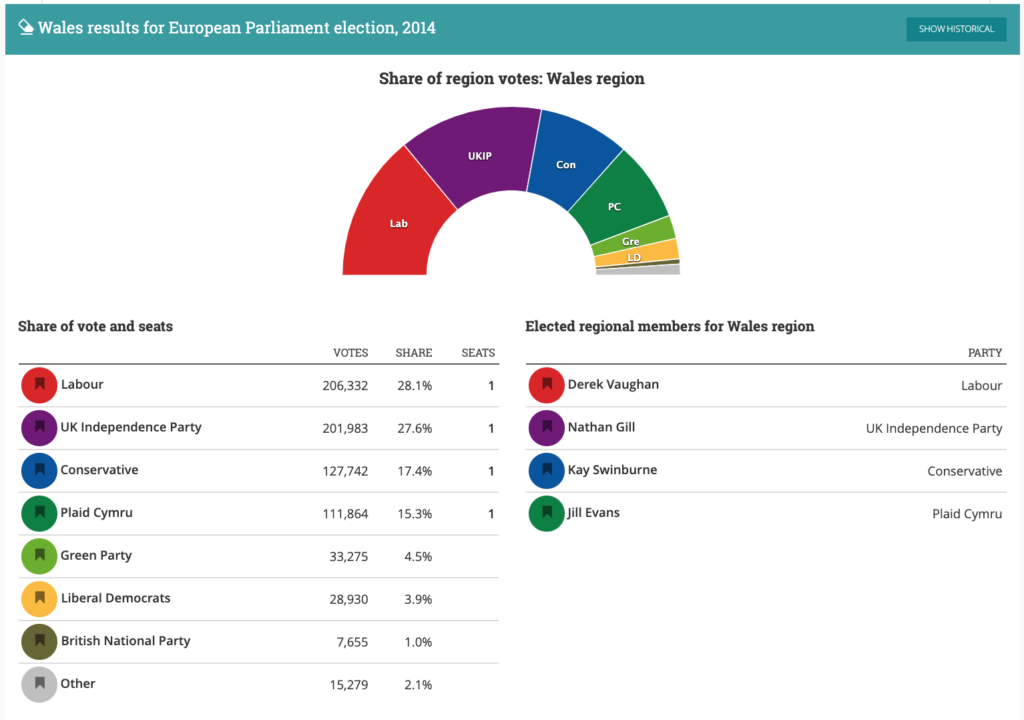European Parliament elections 2019: what will happen in Wales?
When electing MEPs to serve in the European Parliament, Wales has been at least a five-party system for a decade. In both the last two contests the top four parties (Labour, UKIP, the Conservatives and Plaid Cymru) each gained one of the four MEPs, and the Liberal Democrats and Greens lost out. This time around the Brexit Party has replaced UKIP and is doing so well that it should gain two seats to Labour’s and Plaid Cymru’s one each. With voters able to cast only a single vote for a party list, the Democratic Audit team reviews likely outcomes and the candidates that could be elected here.

Cardiff Castle. Picture Margaret Decker from Pixabay
In Westminster elections Wales is a Labour stronghold, with the party repeatedly winning most seats, and also still predominating in Welsh Assembly and local elections. However, as elsewhere in the UK, the European Parliament election can throw up results where voters challenge the locally dominant party. In 2009 the Conservatives narrowly beat Labour to first place. And in 2014, Labour’s 28.2% support was almost equalled by UKIP on 27.6%. Despite receiving substantial EU regional funding, Welsh voters voted 53 to 47% for Brexit in 2016.
A couple of Welsh polls for the European Parliament election have been published in recent weeks, which indicate a strong Brexit Party surge, and Labour support falling. Figure 1 shows the party ordering in two recent YouGov polls. The first was for Plaid Cymru (carried out 10–15 May) and puts the Brexit Party clearly ahead on 33%, with Labour plummeting to 18%. (This is down from 30% in polling by YouGov a month earlier, and 10% down on their 2014 result.) On this basis the Brexit Party would gain two seats, Labour would retain one, and Plaid Cymru, on 16%, would win the final seat. A second YouGov poll published on 19 May has similar results.
These outcomes are not very proportional, and would mean that only two-thirds of voters would elect all the MEPs. This is because Wales has only four seats, so that smaller parties polling below 13–15% have little chance of winning a seat – and this year there are a lot of them. On 9–10% the Liberal Democrats fall short, as do the Greens on 7–8%. The polling puts the Conservatives in sixth place on 5–7%, so they would lose their current seat. Change UK (on 3–4%) and UKIP (now reduced to 3%) are also-rans. Only with a weaker Brexit Party vote, and some really major tactical vote-switching by pro-Remain supporters could the Lib Dems (or Greens) hope to gain a seat. If some pro-Remainers instead switch to Plaid Cymru little can change, since they are currently a long way off winning two seats.
A slightly earlier ComRes poll (with a much smaller Welsh sample) had the parties in the same order but with Labour higher on 26%, and Plaid Cymru somewhat less, perhaps giving one of the other parties a chance for the last seat. However, using a technique called Multi-level Regression and Post-stratification, designed for polls of small geographic samples such as these to take account of demographic data, ComRes then put Labour fractionally in the lead on 29%, with the Brexit Party on 28%, and Plaid and Conservatives down on 10% each. That split could mean that Labour and the Brexit Party gained two seats each, but is a construct only.
So Figure 1 shows that the Welsh election looks pretty resolved (if current polling is correct) with the Brexit Party almost guaranteed two seats, Labour one and Plaid Cymru one. All the parties have six parties standing in the region, though any one listed in the bottom half of their candidate list cannot possibly win a seat under this party list PR system. Voters select just one party to vote for on the ballot paper, not individual candidates. In making up their minds which party list to support, voters need only pay attention to the candidates in the shaded boxes below.
Figure 1: Main party candidates and possible winners from YouGov polling from mid-May

Polling data: First row YouGov for Plaid Cymru (fieldwork (10–15 May); second row YouGov poll published 19 May (fieldwork 8–17 May).
To find details of all the local candidates, and to locate your polling station, visit our Democratic Dashboard site and simply put in your postcode. The site also has full details of other recent elections in your local area.
Below we list a summary of any candidate in Figure 1 with some chance of being elected, and point you to their social media sites, which can show something of what each candidate is like as a person. At the bottom of this article we also show the full 2014 results for the Wales.
Which candidates could be elected in Wales in 2019?
THE BREXIT PARTY – Leading in most polls in Wales, the Brexit Party look pretty certain of winning two seats.
- Nathan Gill (Twitter: @NathanGillMEP) was formerly the Leader of UKIP in Wales. He was elected as an MEP for UKIP in 2014, but is now standing for Farage’s new party. You can find his voting record in the European Parliament and Votewatch.eu profile here. He was also a Wales Assembly Member between 2016 and 2017, although he sat as an independent because of intra-party disputes when Neil Hamilton was selected leader of UKIP in the Assembly,
- James Wells (Twitter: @JamesfWells) ia a former civil servant. He resigned from the Office of National Statistics to stand for the Brexit Party in these elections.
LABOUR – Jackie Jones, who tops the Labour list, is still guaranteed to win a seat. But with the party’s support apparently slumping, Matthew Dorrance only has an outside chance of also winning.
- Jackie Jones (Twitter: @JackieJonesWal1) is a lecturer in law and is a former President of European Women Lawyers Association.
- Matthew Dorrance (Twitter: @MatthewDorrance) is a county councillor and leader of the Labour group in Powys.
PLAID CYMRU – The Welsh nationalist party has been represented in the European Parliament since the current electoral system was established in 1999. If the latest polls are right they will retain their seat.
- Jill Evans (Twitter: @JillEvansMEP) has represented Wales in the European Parliament since 1999. You can view her Votewatch.eu profile and voting record here. She sits on the culture and education committee.
CONSERVATIVES – Their one incumbent MEP is standing down, and on current polling they will struggle to retain a seat here.
- Dan Boucher (Twitter: @DansBoucher) stood for the Conservatives in Swansea East in the 2017 general election, and was third placed on the party list in the European elections in 2014. You can read why he is standing for the Conservatives in the election here.
LIBERAL DEMOCRATS – The Lib Dems have never won a European Parliament seat in Wales, and were in sixth place in 2014, so even with momentum behind them in the latest polling nationally, they only have a small chance of gaining a seat here.
- Sam Bennett (Twitter: @Bennett_Sam) is a former Brecon town councillor and chair of Welsh Young Liberals, who has also worked for Swansea University and for Liberal Democrat MPs and Assembly members.
GREEN PARTY – The party polled fifth here in 2014, but on current polling would seem out of the running to win a seat.
- Anthony Slaughter (Twitter: @as_penarth) is the Leader of the Green Party in Wales and a garden designer.
CHANGE UK – The new party, formed by Ex-Labour and Conservative MPs hoped that having a former Labour minister top of their list would improve their prospects in Wales. It does not seem to have.
- Jon Owen Jones was a Labour MP for Cardiff Central from 1992 to 2005, and junior Welsh minister. You can read his profile here.
UKIP – As elsewhere, UKIP seem entirely eclipsed by the Brexit Party. In Wales their incumbent MEP, plus members of the Assembly, have all defected to the new party.
- Kris Hicks (Twitter @HicksPolitics) is head of press and communications for UKIP, and previously held the same role for the UKIP group in the Welsh Assembly.
Figure 2: 2014 European Parliament results in Wales and MEPs

Source: Democratic Dashboard
Order and current status: 1. Derek Vaughan (Labour); 2 Nathan Gill (elected UKIP, now Brexit Party); 3 Kay Swinburne (Conservatives); 4 Jill Evans (Plaid Cymru).
Read more about how the European Parliament elections work:





 Democratic Audit's core funding is provided by the Joseph Rowntree Charitable Trust. Additional funding is provided by the London School of Economics.
Democratic Audit's core funding is provided by the Joseph Rowntree Charitable Trust. Additional funding is provided by the London School of Economics.